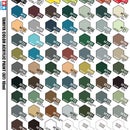Introduction: Re-using LED Bulbs for Blinding Lights!
This is a good way of re-using the LED chips found in light bulbs that use them.
Supplies
1) Eyes
2) Screwdriver + bits
3) Cutting pliers
4) Craft knife
5) Junior Saw [or] Dremel [or] Thin File
6) Crocodile clips [or] Insulated wires
7) Multiple power sources
(lipo batteries help)
(Variable power supply if your equipped with one)
Step 1: Opening the Bulb:
Tear the Led bulb apart! (>:0)
Woah, woah, before you do that you need to take a quick look at what's holding it together. Hmm... is it a FLAT lens cap? Is it a line of rubbery glue? Find out what it is and use one of these methods:
FLAT Lens cap - Look at the clear lens on the top of the bulb and scan your eyes around the edge to see any small clips visible under the lens cap. Then get a thin flat screwdriver head or a prying tool and get between that part of the edge of the lens cap and the cap and see if you can unclip the lens cap, trying a few different positions. Once you've unclipped one, do the rest!
ROUND bulb using glue - This can sometimes be bind but one way to do it is to use a craft knife to try and slice as much of the seal away from the bulb body and the round diffuser. After you've done this, use your hands and your incredible strength to carefully pull this part away from the bulb.
PLEASE DO NOT DO THIS IF THE DIFFUSER IS GLASS! It could shatter!
Step 2: Aquiring the LED Array:
You may notice that the photo above might not look like the array in the bulb you have looks different to this one, that is fine because they will be fixed in the same way.
Anyway, take a look at the screws holding the array in place, they are 99% of the time just a normal cross head, so get the screwdriver and free up those LED's.
Step 3: Clip the Wires
There are going to be 2 wires so cut them so you have as much wire coming from the board as you can so it's easier to connect later. Be careful not to pull them out of the array while you're trying to cut them.
Step 4: Making Contacts
To make exposed contacts to make it easier to run power through an LED separately, I recommend using mini engraver or a Dremel with a abrasive stone to remove the paint-like layer that lies on top of the copper contacts.
Be extra careful to not grind through the contacts themselves because you won't get them back.
Step 5: Seperating the LED's:
[Fig. 1] - First of all you've got to know where you are going to cut the board, so find a good position for a line that bisects the entire board into two pieces, shown as the green lines, and the next cuts are the red lines.
[Fig. 2] - Right, to cut the board you can do this any way you want as long as you make sure you leave the contacts you've made either side of each LED chip, but I personally recommend using a pair of bull nosed pliers or vice padded with some cloth and a junior hack saw to do this.
Then use the bull nosed pliers with some tissue or cloth padding to secure the board and then use the hacksaw to deeply score the board in half by cutting the flat face of the board.
[Fig. 3] - Once you've done this, keep the board in the pliers and bend it back and forth to weaken and snap the board along all the scored lines.
Step 6: POWER+CLEANING:
Power one of the separate sections of the board with a starting voltage of 3v, stepping the voltage up in 0.5v increments each time.
I've found that LED's measuring 3.5mmX3.5mm run on at most 7.2v, but very small ones run on at most 3.6v (convenient for your project, as LiPo's are 3.6v)
Then use a small file and some snips to clean up the sharp edges of the board.
Step 7: DONE!
Thanks for reading this;
Do what you like with this guide and follow me if you want to because why not.
(:P)


